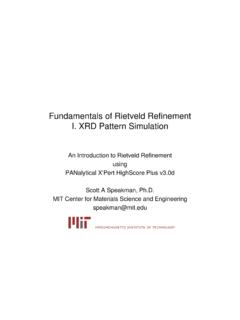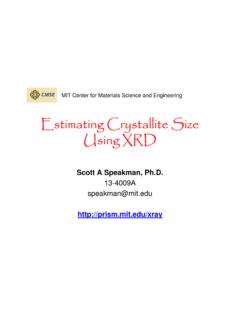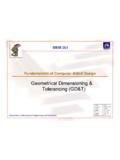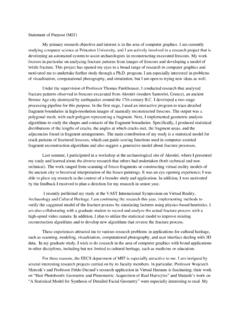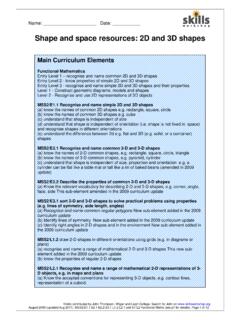Transcription of Basics of X-Ray Powder Diffraction
1 Basics of X-Ray Powder DiffractionTraining to Become an Independent User of the X-Ray SEF at the Center for Materials Science and Engineering at MITS cott A Speakman, 253-6887 Training to Become an Independent User in the X-Ray SEFR equired Safety Training All users must complete the EHS X-Ray Safety training All users must complete the X-Ray Lab Specific Safety Training All users must complete the MIT chemical hygiene training All users must be up to date on their MIT managing hazardous waste training All users must be registered in CMSE MUMMS Specific Training These courses cover how to safely operate instruments to collect data Powder Diffractometers.
2 PANalyticalX PertPro Multipurpose Powder Diffractometer RigakuHigh-Power Powder Diffractometer BrukerD8 with GADDS 2-dimensional detector Other instruments BrukerD8 HRXRD XRFData Analysis Workshops Basic XRPD Data Analysis using HighScorePlus Primary focus is on phase identification, with some discussion on advanced topics such as lattice parameter and crystallite size calculations Profile Fitting and Crystallite Size Determination Profile fitting is the most precise way to determine Diffraction peak position, intensity, and width for calculating lattice parameters and crystallite size RietveldRefinement The Rietveldmethod is used to refine the crystal structure model of a material.
3 It can be used for quantitative phase ID, lattice parameter and crystallite size calculations, and determine atom positions and occupanciesHigh Resolution X-Ray Diffraction (HRXRD) Training HRXRD is used to analyze epitaxial thin films Can determine composition, strain/relaxation, lattice parameters (in-plane and out-of-plane), thickness, and defect concentration X-Ray Reflectivity (XRR) is used to analyze thin films, including amorphous and non-textured films Can determine thickness, roughness, and density Introduction Lecture Instrument training on the BrukerHRXRD HRXRD Data Analysis WorkshopIntroduction to Crystallography and X-Ray Diffraction TheoryDiffraction occurs when light is scattered by a periodic array with long-range order, producing constructive interference at specific angles.
4 The electrons in an atom coherently scatter light. We can regard each atom as a coherent point scatterer The strength with which an atom scatters light is proportional to the number of electrons around the atom. The atoms in a crystal are arranged in a periodic array and thus can diffract light. The wavelength of X rays are similar to the distance between atoms. The scattering of X-rays from atoms produces a Diffraction pattern, which contains information about the atomic arrangement within the crystal Amorphous materials like glass do not have a periodic array with long-range order, so they do not produce a Diffraction patternThe figure below compares the X-Ray Diffraction patterns from 3 different forms of SiO2 These three phases of SiO2are chemically identical Quartz and cristobalitehave two different crystal structures The Si and O atoms are arranged differently.
5 But both have structures with long-range atomic order The difference in their crystal structure is reflected in their different Diffraction patterns The amorphous glass does not have long-range atomic order and therefore produces only broad scattering peaksPosition [ 2 Theta] (Copper (Cu))20304050 Counts0200040000100020003000400002000400 0 SiO2 Glass Quartz CristobaliteThe Diffraction pattern is a product of the unique crystal structure of a material The crystal structure describes the atomic arrangement of a material. When the atoms are arranged differently, a different Diffraction pattern is produced (iequartz vscristobalite)QuartzCristobaliteCrystal line materials are characterized by the long-range orderly periodic arrangements of atoms.
6 The unit cell is the basic repeating unit that defines the crystal structure. The unit cell contains the maximum symmetry that uniquely defines the crystal structure. The unit cell might contain more than one molecule: for example, the quartz unit cell contains 3 complete molecules of SiO2. The crystal system describes the shape of the unit cell The lattice parameters describe the size of the unit cell The unit cell repeats in all dimensions to fill space and produce the macroscopic grains or crystals of the materialCrystal System: hexagonalLattice Parameters: x x (90 x 90 x 120 )Crystal structures focus on symmetry elements to define the atomic arrangement Symmetry in crystal structures is a product of energy minimization in the atomic arrangement Symmetry in the crystal structure often produces symmetry in material properties and behaviorQuartzCrystal System: hexagonalBravaisLattice: primitiveSpace Group: P3221 Lattice Parameters.
7 X x (90 x 90 x 120 )Atom Positions:xyzSi BravaisLattice32screw axis2-fold rotational axisSymmetry elements are used to define seven different crystal systemsCrystal SystemBravaisLatticesSymmetry Axis SystemCubicP, I, Fm3ma=b=c, = = =90 TetragonalP, I4/mmm a=b c, = = =90 HexagonalP, R6/mmm a=b c, = =90 =120 Rhombohedral*R3ma=b=c, = = 90 OrthorhombicP, C,I, Fmmma b c, = = =90 MonoclinicP, C2/ma b c, = =90 90 TriclinicP1a b c, 90 QuartzCrystal System: hexagonalBravaisLattice: primitiveSpace Group: P3221 Lattice Parameters: x x (90 x 90 x 120 ) Diffraction peaks are associated with planes of atoms Miller indices (hkl)are used to identify different planes of atoms Observed Diffraction peaks can be related to planes of atoms to assist in analyzing the atomic structure and microstructure of a samplePosition [ 2 Theta] (Copper (Cu))35404550010201 1 01 0 21 1 12 0 02 0 11 1 20 0 3 Calculated_Profile_00-005-0490 Parallel planes of atomsintersecting the unit cell define directions and distances in the crystal.
8 The Miller indices (hkl) define the reciprocal of the axial intercepts The crystallographic direction, [hkl], is the vector normal to (hkl) dhklis the vector extending from the origin to the plane (hkl) and is normal to (hkl) The vector dhklis used in Bragg s law to determine where Diffraction peaks will be observedThe (200) planes of atoms in NaClThe (220) planes of atoms in NaClUseful things to remember about Miller indices (hkl) is parallel to (n*h n*k n*l) For example, (110) // (220) // (330) // (440) .. Planes are orthogonal if (hkl) (h k l ) = 0 Some planes may be equivalent because of symmetry In a cubic crystal, (100) (010) and (001) are equivalent They are the family of planes {100} [h00] is parallel to the a-axis, [0k0] // b-axis, [00l] // c-axis When analyzing XRD data, we look for trends corresponding to directionality in the crystal structure by analyzing the Miller indices of Diffraction [ 2 Theta] (Copper (Cu))304050607001 0 00 0 21 0 11 0 21 1 01 0 31 1 20 0 42 0 2In this figure, the (002) and (004) peaks (which are parallel to each other)
9 Are much more intense than expected this provides information about the microstructure of the sampleThe position and intensity of peaks in a Diffraction pattern are determined by the crystal structurePosition [ 2 Theta] (Copper (Cu))20304050 Counts0200040000100020003000400002000400 0 SiO2 Glass Quartz CristobaliteThe Diffraction peak position is recorded as the detector angle, 2 .The position of the Diffraction peaks are determined by the distance between parallel planes of atoms. Bragg s law calculates the angle where constructive interference from X-rays scattered by parallel planes of atoms will produce a Diffraction peak. In most diffractometers, the X-Ray wavelength is fixed.
10 Consequently, a family of planes produces a Diffraction peak only at a specific angle 2 . dhklis the vector drawn from the origin of the unit cell to intersect the crystallographic plane (hkl) at a 90 angle. dhkl, the vector magnitude, is the distance between parallel planes of atoms in the family (hkl) dhklis a geometric function of the size and shape of the unit cell sin2hkld=Bragg s LawThe intensity of the Diffraction peaks are determined by the arrangement of atoms in the entire crystal The structure factor Fhklsums the result of scattering from all of the atoms in the unit cell to form a Diffraction peak from the (hkl) planes of atoms The amplitude of scattered light is determined by.


